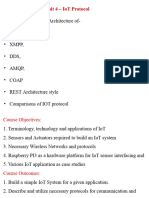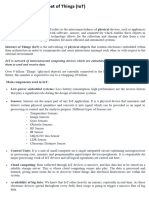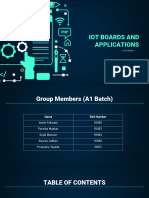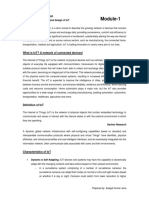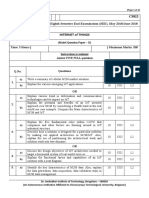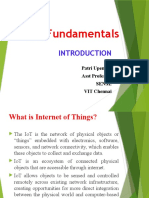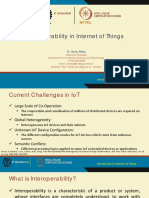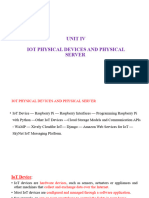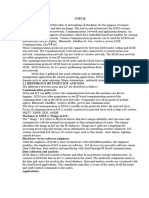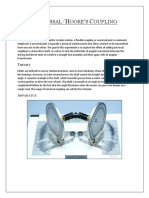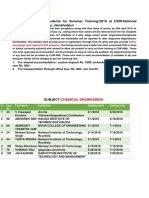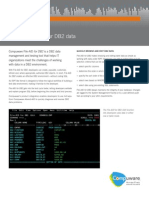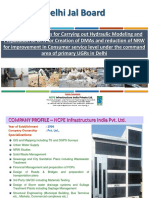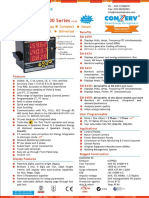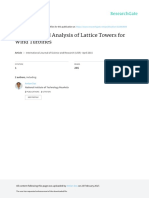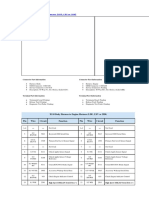Internet of Things
UPM E.U.I.T. Diatel
Xi Chen scotor317@gmail.com
LOGO
�Contents of Introduction
1
Whats Internet of Things
State of the Art of IoT
Challenges and Limitation of IoT
Future of IoT
�Whats the Internet of Things
Definition
(1) The Internet of Things, also called The Internet of
Objects, refers to a wireless network between objects,
usually the network will be wireless and selfconfiguring, such as household appliances.
------Wikipedia
(2) By embedding short-range mobile transceivers
into a wide array of additional gadgets and everyday
items, enabling new forms of communication between
people and things, and between things themselves.
------WSIS 2005
�Whats the Internet of Things
Definition
(3) The term "Internet of Things" has come to
describe a number of technologies and research
disciplines that enable the Internet to reach out into
the real world of physical objects.
------IoT 2008
(4) Things having identities and virtual personalities
operating in smart spaces using intelligent interfaces
to connect and communicate within social,
environmental, and user contexts.
-------IoT in 2020
�Whats the Internet of Things
History
1997, The Internet of Things is the seventh in the series of ITU
Internet Reports
originally launched in 1997 under the title
Challenges to the Network.
1999, Auto-ID Center founded in MIT
2003, EPC Global founded in MIT
2005, Four important technologies of the internet of things was
conference.
proposed in WSIS
2008, First international conference of internet of things: The IOT
Zurich.
2008 was held at
�Whats the Internet of Things
From any time ,any place connectivity for
anyone, we will now have connectivity for
anything!
�Whats the Internet of Things
Characteristics
Ambient
Intelligence
Event
Driven
Internet of Things
Semantic
Sharing
Complex Access
Technologies
Flexible
Structure
�Why Internet of Things
Dynamic control of industry and daily life
Improve the resource utilization ratio
Better relationship between human and nature
Forming an intellectual entity by integrating
human society and physical systems
�Why Internet of Things (ii)
Flexible configuration, P&P
Universal transport & internetworking
Accessibility & Usability?
Acts as technologies integrator
�The application of IoT(1)
Regional Office
House
Transportation Vehicle
Biosensor taken by people
Network
Equipment in public place
Virtual Environment
�The application of IoT(2)
Scenario: shopping
(2) When shopping in the market,
the goods will introduce
themselves.
(1) When entering the doors, scanners
will identify the tags on her clothing.
(4) When paying for the goods, the
microchip of the credit card will
communicate with checkout reader.
(3) When moving the goods, the reader
will tell the staff to put a new one.
�The application of IoT(3)
Scenario: Food
Nutrition
�The application of IoT(4)
Scenario: Health Care
�The application of IoT(5)
Scenario: Intelligent Home
�The application of IoT(6)
Scenario: Transportation
�State of the Art of IoT
Enabling Technologies
RFID
To identify
and track
the data of
things
Sensor
To collect
and process
the data to
detect the
changes in
the physical
status of
things
Smart Tech
To enhance
the power of
the network by
devolving
processing
capabilities to
different part
of the network.
Nano Tech
To make the
smaller and
smaller
things have
the ability to
connect and
interact.
�Sensor technology
The ability to detect changes in the physical status of
things is essential for recording changes in the
environment.
Wireless sensor technology play a pivotal role in bridging
the gap between the physical and virtual worlds, and
enabling things to respond to changes in their physical
environment. Sensors collect data from their
environment, generating information and raising
awareness about context.
Example: sensors in an electronic jacket can collect information
about changes in external temperature and the parameters of the
jacket can be adjusted accordingly
�State of the Art of IoT
Research groups
1
MIT Auto-ID Lab &
EPC Global.
Stanford University
Georgia Institute of
Technology
Cambridge Univ
2
EPFL & ETH Zurich
Information and
Communication
Systems Research
Group
Chemnitz University
of Technology
VSR Group
3
Nokia
SAP
IBM
GOOGLE
AMBIENT
Metro Group
Siemens
Sun
Cisco
GE
�State of the Art of IoT
�The challenge of IoT
Total challenge of IOT
1.Technological Standardization in most areas are still
remain fragmented.
2.managing and fostering rapid innovation is a challenge
for governments
3. privacy and security
4.Absence of governance
�The challenge of IoT
How
How to
to convincing
convincing users
users that
that the
the IoT
IoT technology
technology will
will
protect
protect their
their data
data and
and privacy
privacy when
when tracking
tracking
Potential Solutions
Legal &
Regulatory
Technical
Control
Social Ethic
Market
Self-regulation
�The challenge of IoT
Solution of the main challenge: Education and Information
�The challenge of IoT
Solution of the main challenge: Legislation
�The challenge of IoT
Limitation of IoT
�Future of IOT
Traffic Issue
Production
Daily Life
Logistics
Resource
& Power
Control
Retailing
�Future of IOT
�Future of IOT
�LOGO













